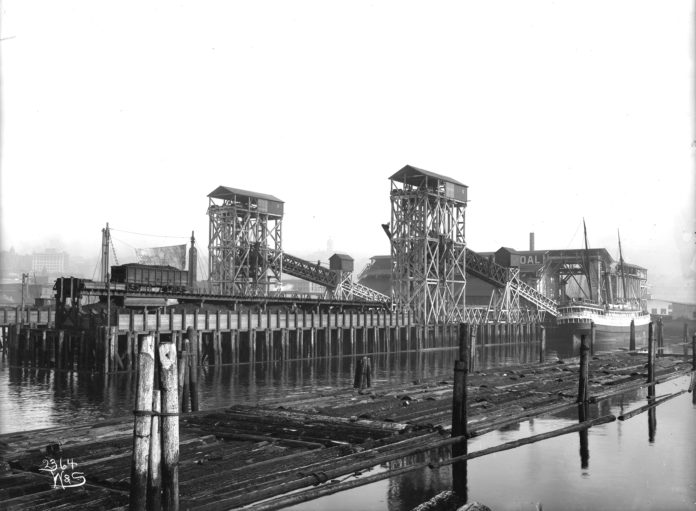Much of the coal mined in Washington was destined for export. This photo of Pacific Coast Coal Company’s Dearborn Street bunkers was taken around 1912. The bunkers were used to unload coal from trains and store the fuel until it was reloaded onto ocean going ships. The site is now a container facility on the Seattle waterfront due west of the Seahawk’s Century Link stadium. According to a July 1909 Marine Review report, from a fuel standpoint Seattle’s harbor was the best on the Pacific Coast. The coal mines were close, the fuel was cheap, and the three bunkers in the harbor were large, well-equipped, and modern. Northern Pacific’s railway bunkers were in West Seattle; with the Roslyn’s Fuel Co. at the foot of Clay Street; while Pacific Coast’s facilities were the largest. The Dearborn bunkers consisted of a storage house parallel to the harbor line with a capacity of 5,000 tons. It was served by an incline trestle at a right angle that could hold 20 standard coal cars. Two loading chutes for conveying coal to a ship’s cargo hold each had a capacity of 400 tons per hour. At the time Black Diamond mine-run coal was delivered by rail, f.o.b. to the bunkers for $3.75 per gross ton (2,240 pounds). These facilities were still operating in the 1940s. At that time Virgil Ungherini worked for the Pacific Coast Railroad, a sister company. He remembered how difficult it was to navigate the rail cars filled with coal: “I used to sweat that! It was a sharp blind curve and upgrade onto a bunker, plus a street crossing where people would run into you at night.” This photo comes courtesy of the Pacific North West Railroad Archives in Burien.
Home Features When Coal Was King WHEN COAL WAS KING: Pacific Coast Coal Company’s Dearborn Street bunkers was...









